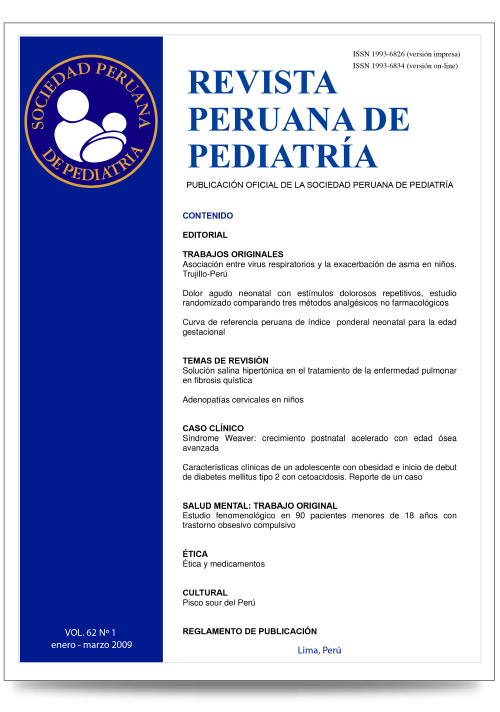Neonatal acute pain with repeated painful stimuli, randomized trial comparing three analgesic non pharmacological methods
DOI:
https://doi.org/10.61651/rped.2009v62n1p08-14Keywords:
PainAbstract
Introduction: Non pharmacological methods are rarely used in neonatal units. repeated painful stimuli have long noxious effects.
Objective: To verify the effectiveness of non pharmacological methods in repeated painful procedures; to determine which method is more effective.
Material and methods: We conducted a randomized controlled trial. Newborns were randomly assigned into 3 groups (n=40 per group). All of them underwent painful procedures during the first 3 days of life (hepatitis B, BCG and blood sample for determine group and factor). Group A received breast feeding and skin to skin contact as non pharmacological method during the painful stimuli, group B received dextrose 10% and group C only suction. Douleur Aigue Nouveau-ne scores (DAN, Carvajal et al.) and ABC scale (Bellieni et al.) were used to assess neonatal pain. The 3 groups were compared in each stimulus to determine the most effective method, and the effectiveness in repeated painful stimuli.
Results: Group B showed the most analgesic effect in the 3 stimuli, with 97, 5% for NO PAIN vs. 87, 5% (A) and 85% (C) (p<0,036) with ABC scale, and 95% vs. 85% (A) and 70% (C) for NO PAIN with DAN scale (p<0,022). This difference was constant with all categories of pain. We observed that analgesic effect is greater in repeated painful stimuli. NO PAIN category was 70% in group B in the first stimuli, 85% in the second and 95% in third (p<0,020). This effect was also observed in groups A and C.
Conclusions: Dextrose 10% seems to offer the best analgesic effect compared with breast feeding and suction. Non pharmacological methods studied increase their effectiveness in repeated painful stimuli.
Downloads
Downloads
Published
How to Cite
License

This work is licensed under a Creative Commons Attribution 4.0 International License.
Authors will retain the copyright and grant the right to publish their work in the journal while allowing third parties to share it under the Creative Commons Attribution license.
Articles are published under a Creative Commons license that allows sharing and adaptation with appropriate credit. CC BY 4.0 license. Available in English at https://creativecommons.org/licenses/by/4.0/
Authors may use other information disclosure formats as long as the initial publication in the journal is cited. The dissemination of the work through the Internet is recommended to increase citations and promote academic exchanges.
The published content does not necessarily reflect the specific point of view of the journal, and the authors assume full responsibility for the content of their article.




